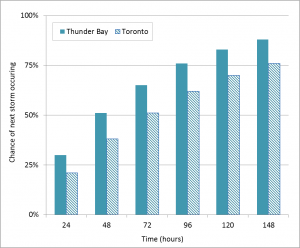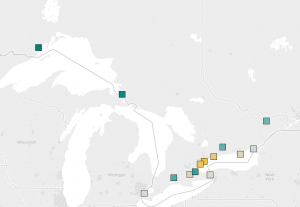Difference between revisions of "Drainage time"
Jenny Hill (talk | contribs) |
Jenny Hill (talk | contribs) |
||
| Line 5: | Line 5: | ||
| − | [[File:Interevent times.PNG|thumb|https://public.tableau.com/views/StormIntereventTimesOntario/Sheet1?:embed=y&:display_count=yes&publish=yes]] | + | [[File:Interevent times.PNG|thumb|link=https://public.tableau.com/views/StormIntereventTimesOntario/Sheet1?:embed=y&:display_count=yes&publish=yes|Darker teal locations have more frequent rainfall, the darker yellow have the least frequent rainfall, all other fit in between. This image links to the Tableau page where the data may be viewed in more detail.]] |
| − | The analysis was conducted using the recommended minimum inter-event time of 12 hours from the MOECC<ref>MOECC Rainfall analysis 2017 </ref>, and earlier rainfall probability distribution parameters from 1960's-1980's <ref>Adams, B. J., and Papa, F. (2000). Urban stormwater management planning with analytical probabilistic models. Wiley.</ref>.It is not anticipated that recent incremental changes to our climate will have significantly impacted this broad window of recommended drawdown times. | + | The analysis was conducted using the recommended minimum inter-event time of 12 hours from the MOECC<ref>MOECC Rainfall analysis 2017 </ref>, and earlier rainfall probability distribution parameters from 1960's-1980's <ref>Adams, B. J., and Papa, F. (2000). Urban stormwater management planning with analytical probabilistic models. Wiley.</ref>. |
| + | It is not anticipated that recent incremental changes to our climate will have significantly impacted this broad window of recommended drawdown times. | ||
The map shows the individual locations including: | The map shows the individual locations including: | ||
*Brantford | *Brantford | ||
Revision as of 15:20, 7 September 2017
The recommended drawdown times for all storage and infiltration facilities are based upon rainfall statistics and likelihood that the facility will have regenerated storage capacity before the arrival of the next storm event. A summary analysis of 14 weather stations across Ontario found that storms are most frequent in Thunder Bay and least frequent in Toronto. The bar graph shows that there is approximately a 50% chance of rainfall occurring again within 48 hours (Thunder Bay) to 72 hours (Toronto).
The analysis was conducted using the recommended minimum inter-event time of 12 hours from the MOECC[1], and earlier rainfall probability distribution parameters from 1960's-1980's [2]. It is not anticipated that recent incremental changes to our climate will have significantly impacted this broad window of recommended drawdown times. The map shows the individual locations including:
- Brantford
- Etobicoke
- Hamilton
- Kingston
- London
- Niagara Falls
- Oshawa
- Ottawa
- Peterborough
- Sault Ste Marie
- Thunder Bay
- Toronto
- Trenton
- Windsor

